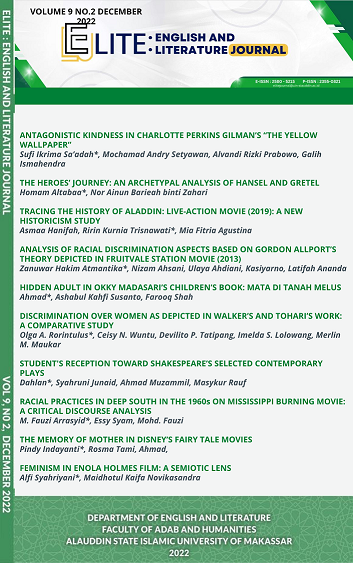FEMINISM IN ENOLA HOLMES FILM: A SEMIOTIC LENS
Abstract
Film is not merely a medium to entertain but also a reflection of society's values and conditions. This research deals with the portrayal of feminism in the film of Enola Holmes in the era of 19th century through its main character of the film ‘Enola’. It uses the qualitative method by employing the theory of semiotics of Charles Sanders Peirce, which categorizes signs into three related parts, namely representamen, object, and interpretant. The data was taken by identifying and interpreting the signs through the scenes of the films, including icon, index, and symbol. The findings show that the film represents the feminist values through the character of Enola, such as independent, intellectual, showing freedom of choice, gender equality, and right to privacy. The character challenged the social norms in the 19th century, which still positioned women as inferior social beings and were oppressed by the patriarchal system. The film also brings relevant messages as it also indirectly criticizes the present women issues through the historical lens.
Downloads
References
Budgeon, S. (2015). Individualized femininity and feminist politics of choice. European Journal of Women's Studies, 22 (3), 303-318. https://doi.org/10.1177/1350506815576
Creswell, J. . (2013). Research Design. SAGE publications.
Danesi, M. (2004). Messages, Signs, and Meanings. A Basic Textbook in Semiotics and Communication Theory. 3rd edition. Toronto: Canadian Scholars' Press Inc.
Dawkins, R. (2020). From the perspective of the object in semiotics: Deleuze and Peirce. Semiotica. https://doi.org/10.1515/sem-2017-0154
Fahmi, N. (2015). An Analysis of Liberal Feminism through Main Character Roles of Aung Suu Kyi The Lady Film. Thesis. UIN Syarif Hidayatullah Jakarta.
Finlayson, L. (2016). An Introduction to Feminism. Cambridge: Cambridge University Press.
Floreani, S. (2021). Why Digital Privacy is a Feminist Issue. in https://overland.org.au/2021/02/why-digital-privacy-is-a-feminist-issue/comment-page-1/
Gooniyah, A. F., Army, A., & Muwaffaq, T. (2022). Enola Holmes Case: An Invasive Pastiche for Embodying a Holmes Sister as the Feministic Detective. prosodi, 28-39. https://journal.trunojoyo.ac.id/prosodi/article/view/13374
Hooks, B. (1984). Feminist Theory: from Margin to Center. Cam., Mass.: South End Press.
Hughes, K. (2014, May 15). Gender roles in the 19th Century. Romantics and Victorians. https://www.bl.uk/romantics-and-victorians/articles/gender-roles-in-the-19th-century
Pilcher, J & Whelehan, I. (2017). Key Concepts in Gender Studies. Los Angeles: SAGE.Ltd
Lindsey, L. L. (2021). The Sociology of Gender Theoretical Perspectives and Feminist Frameworks. In Gender Roles. https://doi.org/10.4324/9781315664095-6
Musrifah. (2018). Feminisme Liberal dalam Novel Sepenggal Bulan Karya Zhaenal Fanani. Lingua Franca, 2, 82–100. http://dx.doi.org/10.30651/lf.v2i1.1438
Nur, E & Mudjiyanto, B. (2013). Semiotics in Research Method of Communication. Jurnal Penelitian Komunikasi, Informatika dan Media Massa - Pekommas, 74.
Nsaidzedze, I. (2017). An Overview of Feminism in the Victorian Period [1832-1901]. American Research Journal of English and Literature, 1-18. DOI:10.21694/2378-9026.17012
Pertiwi, F.D., Sudrajat, A., Kumalasari, D., Retnawati, H., Waspada, S. P., Dossayeva, S. K,. Kasymova, G.K,. (2019). Gender Equality in Feminism in The National Academy of Sciences of the Republic of Kazakhstan, 112-121.
Purnamasari, D. et al. (2020). Brave and hardworking: A Feminist Analysis on Children Fairytale "The Lazy Girl". Elite: English and Literature Journal, 1-12. https://doi.org/10.24252/elite.v7i1a1.
Qiu, L. (2017). Elizabeth Jane—An Independent Woman. ELLS, 94. http://www.ccsenet.org/journal/index.php/ells/article/view/69866
Richardson, J. (2014). Spinoza, Feminism and Privacy: Exploring an Immanent Ethics of Privacy. Feminist Legal Study, 22 (3), 225-241. DOI:10.1007/s10691-014-9271-3
Wulandari, S & Siregar, E. D. (2020). Charles Sanders Pierce Semiotic Study: Tricotomic Relations (Icons, Index And Symbol). Jurnal Ilmu Humaniora, 31-32. https://doi.org/10.22437/titian.v4i1.9554
Waling, A. (2018). Rethinking Masculinity Studies: Feminism, Masculinity, and Postsructural Accounts of Agency and Emotional Reflexivity. The Journal of Men’s Studies. https://doi.org/10.1177/1060826518782
Saputri, S.M.T. & Neisya. (2021). Woman's Struggle Towards Stereotypes in the Case of the Missing Marquess. An Enola Holmes. Elite: English and Literature Journal, 54-65. https://doi.org/10.24252/10.24252/elite.v8i2a5.
Nöth, W. (2020). Handbook of Semiotics. In Handbook of Semiotics. https://doi.org/10.2307/j.ctv14npk46
Rahajeng, A. A. (2020). The representation of gender expression in movie “Enola Holmes.” Universitas Pelita Harapan.
Roberts, H. E. (1977). The Exquisite Slave: The Role of Clothes in the Making of the Victorian Woman. Signs, 2(3), 554–569. http://www.jstor.org/stable/3173265
Yildirim, A.H. (2012). The Woman Question and the Victorian Literature on Gender. Ekev Academic Review, 45-54.
Copyright (c) 2022 Alfi Syahriyani, Maidhotul Kaifa Novikasandra

This work is licensed under a Creative Commons Attribution-NonCommercial-ShareAlike 4.0 International License.
Once an article was published in the journal, the author(s) are:
granted to the journal right licensed under Creative Commons License Attribution that allows others to share the work with an acknowledgement of the work's authorship.
permitted to publish their work online in third parties as it can lead wider dissemination of the work.
continue to be the copyright owner and allow the journal to publish the article with the CC BY-NC-SA 4.0 license
receiving a DOI (Digital Object Identifier) of the work.


